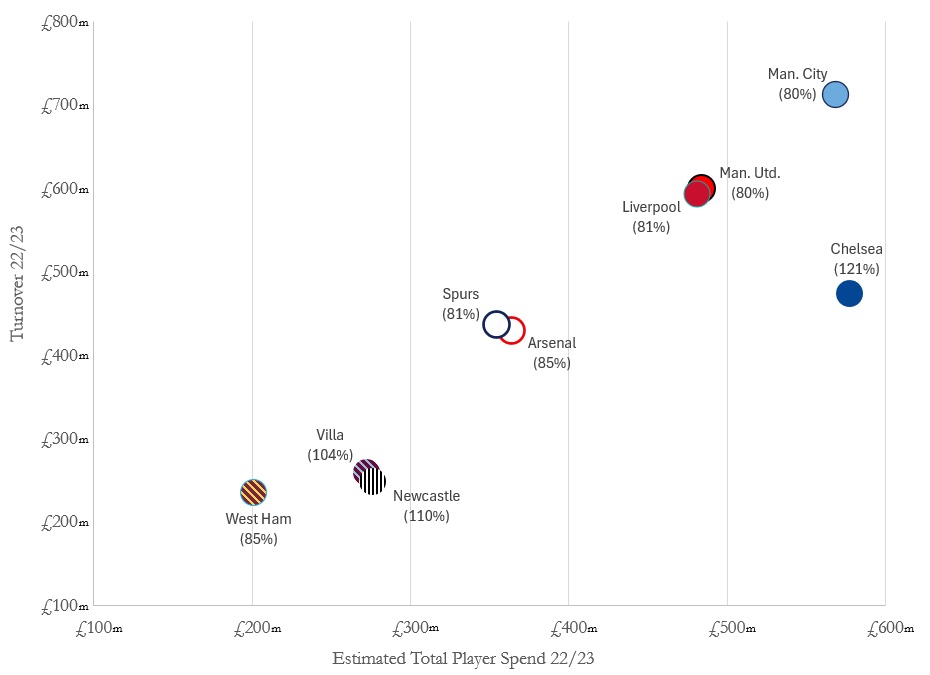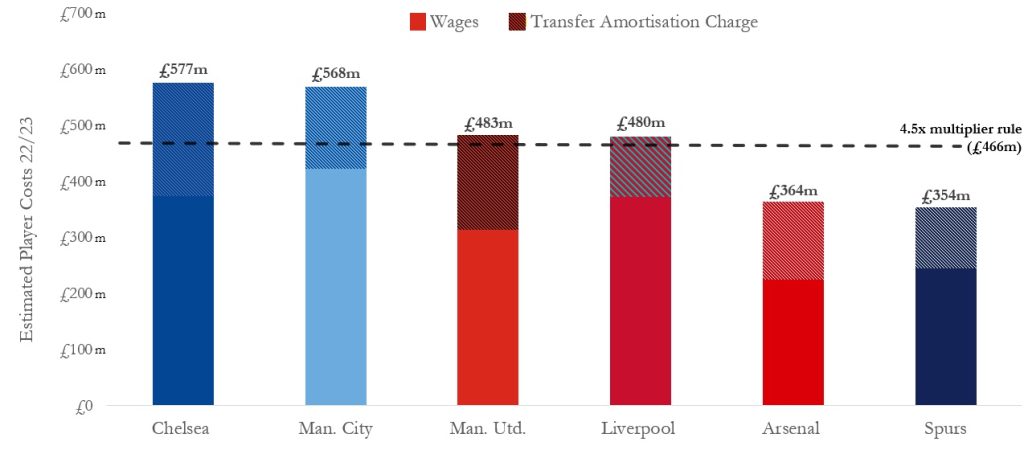A new Premier League ‘anchoring’ rule could cause problems for the so-called ‘Big Six’ clubs in the 2025/26 season.
Chelsea is the top club most at risk of breaching the new requirements, and could be forced to slash their spending by almost 20%.
The Blues are already widely expected to have to sell homegrown players this summer, as it is only some creative accounting that has allowed them to avoid breaching the Premier League’s current rules.
Why do we need an anchoring rule and what is it?
Premier League clubs have voted to introduce a new cap on spending to replace the current Profit and Sustainability Rules (PSR), which have seen points controversially deducted from Everton and Nottingham Forest this season.
The new spending rules, if approved in a final vote, will allow Premier League clubs to spend 85% of their revenue on player costs, though clubs playing in European competitions would still have to abide by UEFA’s 70% spend cap.
A quick look at the data will tell you that Chelsea are currently spending more than 120% of their turnover on their squad, a significant amount over the proposed cap.
Michael Andreaou, a taxi driver and lifelong Chelsea fan, said: “Obviously I’m nervous about these new rules. Chelsea has spent a lot of money lately, but the team still isn’t where it needs to be.
“We’ve signed players on long contracts for high wages, which I imagine is going to cause us problems if these rules and regulations are brought in.
“As a fan, I just don’t want to see the club fall behind. Our mismanagement isn’t the fault of the supporters who love this club.”

Nevertheless, a revenue-based system means that the richest clubs would always be able to spend more than poorer clubs.
West Ham, Aston Villa and Newcastle are all competing regularly for Europe and both on the field and financially are three of the Premier League clubs closest to tackling the ‘Big Six’.
However, the wealthier clubs are still able to spend many hundreds of millions more than their competitors for European spots while spending a lower percentage of their revenue.
In the 2022/23 season, Manchester City spent £568 million on player costs. This would be equivalent to West Ham spending 241% of their revenue but for City, it is only 80%.
The introduction of an 85% spend cap would require clubs like Aston Villa and Newcastle to decrease their spending by more than 20%, while for five of the Big Six business could continue as usual (high-spending Chelsea are the exception).
One caveat of course, is that Newcastle are owned by the Saudi Arabian Public Investment Fund, so are expected to scale up their turnover significantly in the next few years.
Joe Conlan, a brewer and West Ham fan from East London, said: “The spending cap would be completely elitist and would widen the gap between ‘the other 14’ and the rest of the league.
“It would only benefit teams with a bottomless pit of money, who can afford to inject money into their youth teams and sell the players later to make up the money.
“As with all these types of rules, the richest will find a way around them, and the regular clubs will be left struggling.”
The ‘anchoring’ rule is a potential solution to this problem, linking the maximum spend on transfers, wages and agents’ fees to a multiple of what the league’s bottom club earns from broadcast revenue.
How might this affect the Big Six?

Looking at the most recent published accounts of Big Six clubs gives us an idea of how anchoring rules might affect them.
North London rivals Tottenham Hotspur and Arsenal would have plenty of wiggle room under the new anchoring rule, meaning that they could actually increase their spending.
Hannah Benjamin-Cook, a financial journalist at Bloomberg and member of the Women of the Lane Spurs Supporters’ group, said: “I think Spurs have for many years shown that they operate with a very disciplined approach to spending, but I do believe that there have been numerous occasions when we’ve gone for the cheaper option or initial loan deals in order to not lay out huge sums of cash.
“This approach has overwhelmingly not worked in terms of player quality.
“On the flip side, our record signing, Tanguy Ndombele, proved to be absolutely useless, so it doesn’t necessarily equate that spending big brings big rewards.
“Also, when you look at Everton taking a points hit, and some sort of sanctions possibly coming for Manchester City as well, the upside to being prudent with spending is that we obviously don’t run the risk of breaching spending rules.”
As for the other clubs, the two biggest teams in English football history, Manchester United and Liverpool, would be slightly in excess of the anchoring spend cap.
For Manchester United, a large chunk (£170m) of their spend is on transfer amortisation, while for Liverpool, the majority of their spend (£373m) is on wages.
Both clubs could stay under the limit with a few tweaks to their budgets.
As such, we may see some high-wage players leaving Liverpool over coming transfer windows (their two biggest earners are both out of contract next summer), while Manchester United will need to avoid large transfer fees.
However, Manchester City and Chelsea would both be far in excess of the proposed anchor, due to large wage bills and high transfer costs.
Both clubs would need to restructure their approach from the 2022/23 season in order to prepare for the potential introduction of the new rules in the summer of 2025, with Chelsea needing to slash spending by 19% and Manchester City by 17%.
What are the criticisms?
Of the Big Six, Manchester City and Manchester United have voted against the new rules, while Chelsea has abstained from the vote.
All three clubs would be required to slash their spending if the anchoring rules were approved.
However, some fans and experts fear that the biggest clubs will continue to find workarounds in order to flex their financial power.
Sports journalist, author and broadcaster Kieran Maguire said: “The cap seems strange as it focuses on one form of revenue (broadcast) but ignores the main other ones in the form of commercial and matchday.
“The fear from some clubs is that the big ‘brands’ in football will leverage their advantage to create an even bigger financial advantage.”
Financial inequality in the Premier League has made some fans of Championship teams wary of promotion, unconvinced that a change to the rules will make a difference.
Olivier Lennon is a Stoke City fan and a Mathematician at the University of Oxford.
He said: “I find it interesting that fans of the Premier League complain now about the near-total dominance of a state-backed club like Manchester City.
“To a fan of a club from a lower league, it has felt like this my whole life. It is nearly impossible to break into and remain in the upper echelons of the game without huge capital and investment.
“What does a fan like me have to hope for? Promotion, only to remain a few seasons before being relegated again having won only a handful of games each season?
“A healthy football pyramid has constant renewal, ebbs and flows. What we have with the current Big Six and their spending power is stagnation.
“Sure, it’s great for fans of those teams, but there are far more of us than there are of them. It really is a game between the ‘haves’ and the ‘have nots.’ I don’t see that changing any time soon.”
Premier League clubs will vote on the introduction of anchoring at the Premier League AGM on 6 June.





